As an Amazon Associate KitchenwareSets.com earns from qualifying purchases.
7 Japanese Kitchen Layout Secrets for Modern Homes
Is your kitchen a source of stress instead of serenity? For many, the kitchen is the most chaotic room in the home—a jumble of appliances, overflowing drawers, and cluttered countertops that makes cooking feel more like a chore than a creative joy. This constant battle with disorganization can leave you feeling drained and uninspired, wondering if it’s even possible to have a space that’s both highly practical for a busy life and peacefully beautiful. You’re not just looking for more storage; you’re craving a fundamental shift in how your kitchen feels and functions, a transformation from a place of clutter to a sanctuary of calm.
What if the solution wasn’t about bigger cabinets or more counter space, but a different philosophy entirely? A Japanese kitchen layout offers exactly that. It prioritizes minimalism, natural materials, and an ergonomic workflow to create a space that is both exceptionally functional and deeply serene. By focusing on decluttering surfaces, optimizing every inch of storage, and fostering a strong connection to nature, this design approach transforms your kitchen into a harmonious environment where cooking becomes a peaceful and efficient experience. As a content strategist who has analyzed countless design transformations, I’ve seen firsthand how these timeless Japanese principles can solve the most common modern kitchen frustrations.
This guide will walk you through seven essential secrets of the Japanese kitchen layout. We’ll explore actionable steps and design principles that you can apply to your own home, whether you’re planning a full renovation or just looking for ways to bring more order and beauty into your current space. Prepare to discover how to create a kitchen that not only works flawlessly but also nurtures a sense of tranquility and joy every single day.
Craving a Kitchen That’s Both Beautifully Calm and Hyper-Functional?
For many modern homeowners, the kitchen represents a central conflict: the desire for a serene, beautiful space versus the need for ultimate functionality in a high-traffic area. Does your current kitchen layout feel inefficient, with a constant battle against cluttered surfaces? In many homes, especially those with small or open-plan spaces, the kitchen can quickly become a zone of stress. This isn’t just about aesthetics; a poorly designed kitchen creates friction in your daily routine, making cooking and cleaning more time-consuming and less enjoyable. You might find yourself wishing for a space that feels less like a chaotic workshop and more like a peaceful retreat, a place where everything has its purpose and its place.
The answer lies in shifting your perspective from simply storing things to creating a harmonious environment. This is the core philosophy behind Japanese kitchen design, an approach that masterfully blends minimalism, functionality, and a deep respect for nature. It’s not about stark, empty rooms; it’s about intentionality. A Japanese kitchen layout is engineered for an ergonomic “Zen” flow, ensuring every movement is efficient and every tool is easily accessible yet hidden from sight. It’s a solution that addresses the root cause of kitchen chaos—the lack of a thoughtful, integrated system. By embracing these principles, you can transform your kitchen from a source of daily frustration into the calm, hyper-functional heart of your home.
7 Japanese Kitchen Layout Secrets for Modern Homes in 2025
Ready to transform your kitchen into a sanctuary of calm and efficiency? The secret lies in the timeless principles of Japanese design. These aren’t just aesthetic choices; they are foundational pillars that create a kitchen that is both beautiful to behold and a dream to work in. Whether you have a small apartment kitchen or a large open-plan space, these seven secrets will provide you with a blueprint for creating a modern Japanese kitchen layout in your own home.
These curated principles, drawn from the work of leading interior design experts and analyses of authentic Japanese homes, will guide you through the process. For each “secret,” we will dive into practical, actionable steps and provide visual inspiration to help you see how these ideas can come to life. Prepare to learn how to master minimalism, harness the beauty of natural materials, and optimize your workflow for a truly serene and functional culinary space.
1. The Secret of “Ma”: Embrace Clutter-Free Surfaces
The foundational secret to a Japanese kitchen is embracing the concept of “Ma,” or negative space, by keeping surfaces radically clutter-free. This isn’t about having nothing; it’s about creating a visual calm that allows the mind to feel relaxed and focused. In practice, this means every item has a designated home hidden away, countertops are clear, and appliances are integrated seamlessly. This principle contributes to an atmosphere of freedom and ease, where the kitchen feels spacious and orderly, regardless of its actual size. The goal is to ensure every visible element is intentional and beautiful.
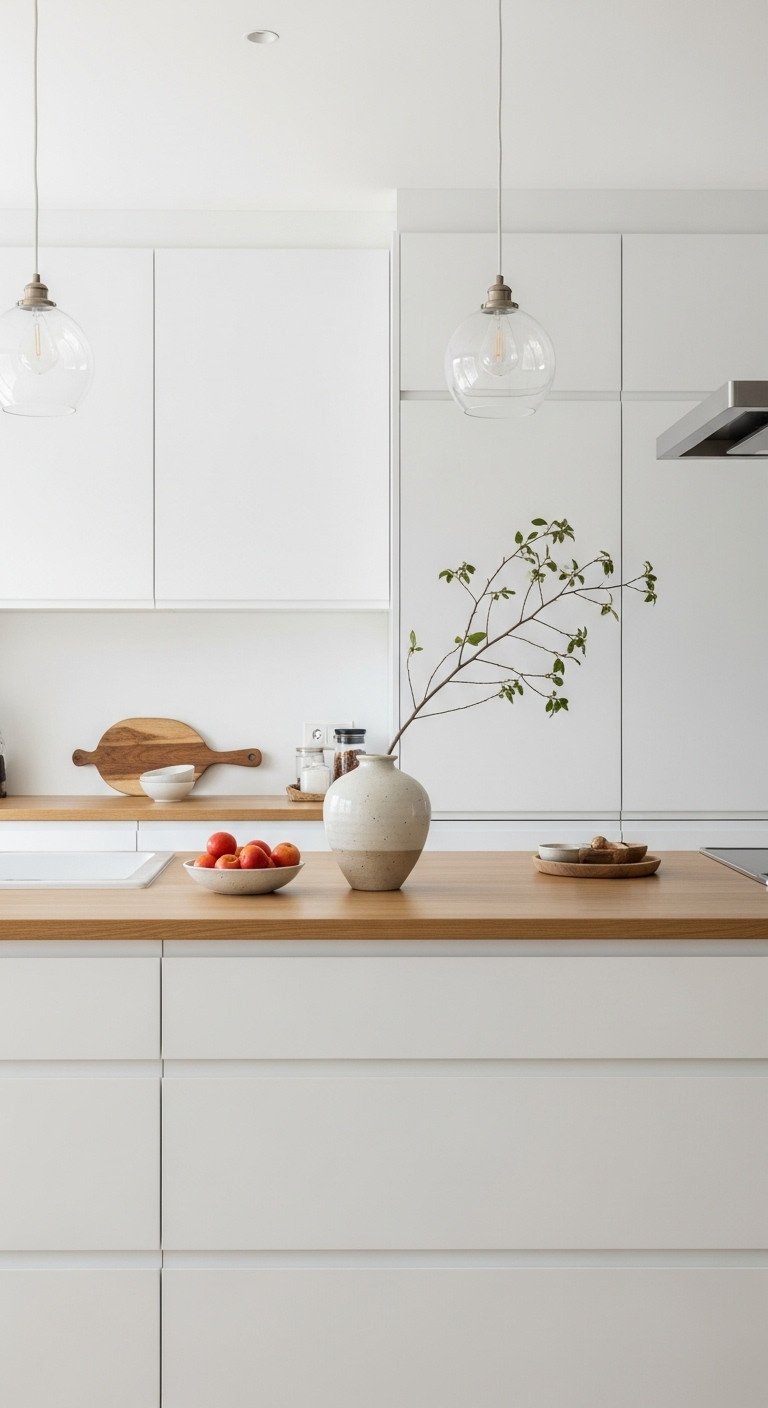
Save this idea to your ‘Minimalist Kitchen’ board!
- Materials Needed: In-drawer organizers, pull-out pantry systems, appliance garage cabinet kits, handleless cabinet hardware.
- Step-by-Step Directions:
- Audit all countertop items. Begin by taking everything off your counters and assigning each item a designated “home” inside a cabinet or drawer. Be ruthless—if you don’t use it daily, it shouldn’t live on the counter.
- Install modular drawer organizers for cutlery, utensils, and spices. A high-quality, expandable bamboo drawer organizer is perfect for this, as it can be adjusted to fit your drawer perfectly and its natural material aligns with the Japanese aesthetic.
- Consolidate small appliances like toasters, blenders, and coffee makers into a dedicated “appliance garage” or a specific cabinet to keep them powered up but out of sight.
- If you’re renovating, opt for fully integrated appliances that sit flush with your cabinetry and choose flat-panel, handleless cabinets. This creates a seamless, unbroken visual line that is central to a minimalist look.
Pro-Tip: Before buying any organizers, empty your drawers and group all the items by function and size. This simple act of pre-organizing ensures you purchase the exact type of expandable drawer divider or insert you actually need, saving you time and money.
2. The Secret of “Shizen”: Utilize Natural Materials & Colors
The secret of “Shizen” is about inviting nature into your kitchen through the extensive use of natural materials and an earthy color palette. This core principle is paramount in Japanese design for creating a warm, organic, and harmonious atmosphere. The focus is on tactile materials like wood (often light oak or rich American walnut), stone for countertops, and bamboo accents. These elements are complemented by a muted and warm color scheme featuring neutral tones like sand, beige, cream, and various shades of white. This grounds the space and fosters a deep sense of tranquility.
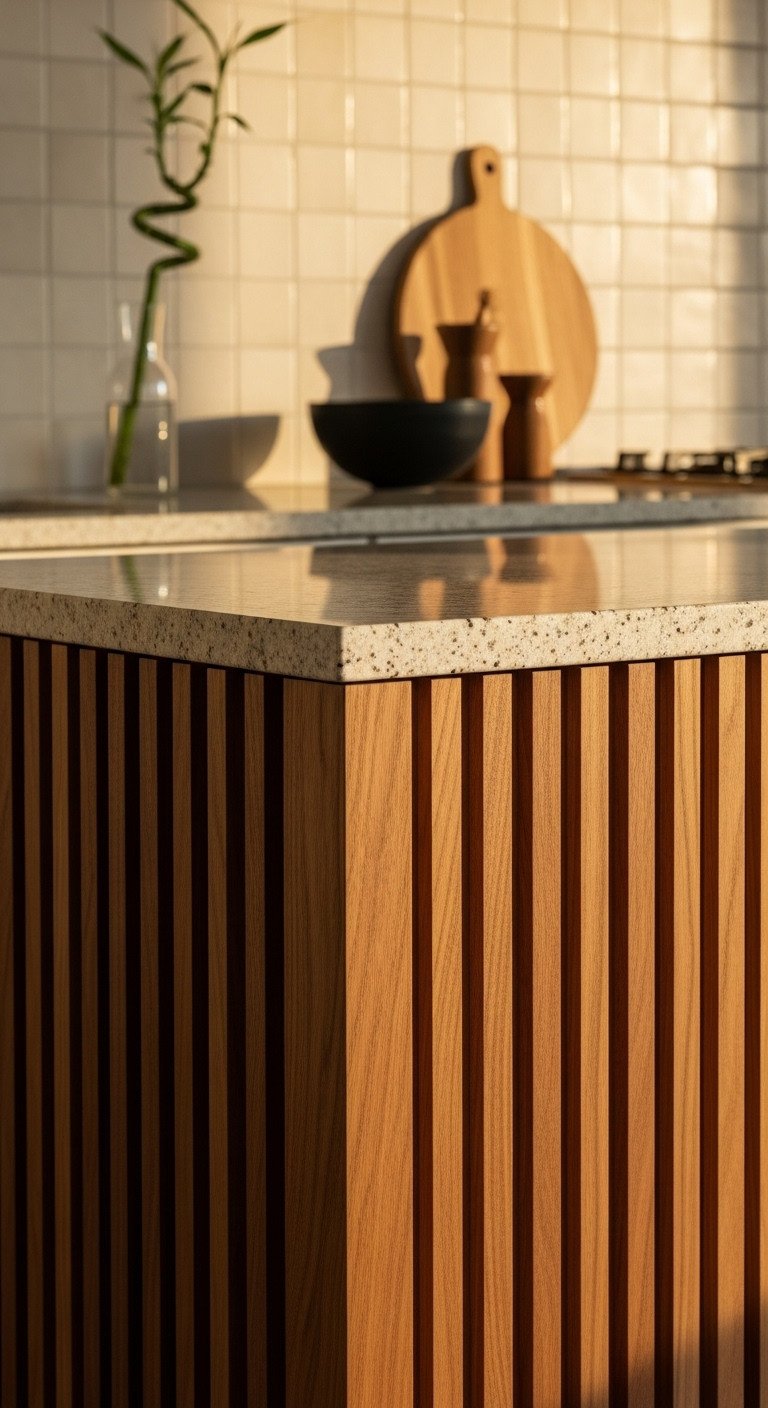
Save this texture inspiration to your ‘Japandi Design’ board!
- Materials Needed: Wood samples (oak, walnut), stone countertop samples, bamboo decor items, neutral paint swatches (beige, cream, sand).
- Step-by-Step Directions:
- Choose a primary wood tone to anchor your design. Light oak is fantastic for creating an airy, Scandinavian-influenced Japandi feel, while a darker American walnut offers a more traditional, grounded, and sophisticated look for cabinets or flooring.
- Select a durable, natural stone like granite or a high-quality composite quartz for your countertops. Choose a light, neutral color to reflect light and keep the space feeling bright and open.
- Incorporate bamboo elements through smaller, functional items. Using a bamboo dish rack or utensil holders is an easy and affordable way to add this quintessential Japanese texture to your kitchen.
- Paint your walls in warm, earthy neutral colors like beige, sand, or a soft off-white. This creates a serene backdrop that allows the natural beauty of the wood and stone to be the true stars of the space.
Lesson Learned: Always view your material and paint samples in your kitchen’s actual lighting conditions at different times of the day. A color or wood tone that looks perfect under the fluorescent lights of a showroom can look completely different in the warm morning sun or cool evening light of your own home.
3. The Secret of Ergonomic “Zen” Flow: Optimize Your Workspace
An ergonomic “Zen” flow is achieved by meticulously planning your kitchen layout to minimize unnecessary movement and maximize efficiency. This goes beyond the classic “work triangle” and focuses on creating dedicated functional zones for prepping, cooking, and cleaning. In Japanese design, especially in smaller urban homes, every inch is optimized. This involves strategically placed storage, pull-out drawers, and hidden solutions that maintain a clean aesthetic while making the entire cooking process seamless and intuitive. The goal is a workspace that feels like a natural extension of the cook’s movements.
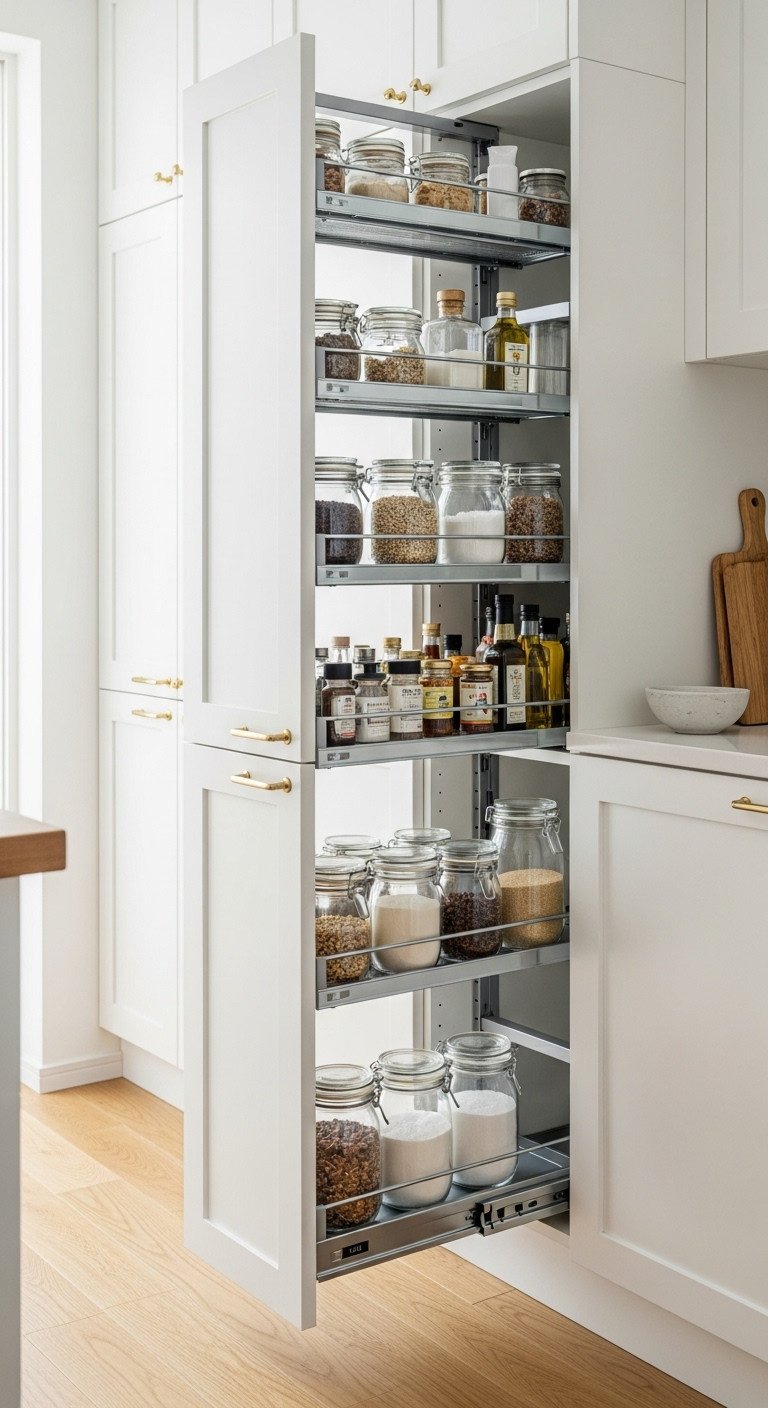
Pin this genius organization hack for later!
- Materials Needed: Pull-out cabinet organizers, lazy susans for corner cabinets, drawer dividers, ergonomic anti-fatigue mat.
- Step-by-Step Directions:
- Analyze your cooking process from start to finish. Group all items needed for a specific task together. For example, keep baking sheets, mixing bowls, and flour near the oven and your primary prep surface.
- Make use of vertical space and tricky corners. Install a heavy-duty pull-out cabinet organizer in a deep pantry. This allows you to see and access everything, even items at the very back, without having to unload the entire shelf.
- Retrofit your lower cabinets with sliding shelves. This simple upgrade is a game-changer, preventing you from having to bend down and dig through stacks of pots and pans.
- Place a high-quality, ergonomic anti-fatigue mat in your primary work zone, typically the area between the sink and the stove. This will significantly reduce strain on your back and legs during long cooking sessions.
Pro-Tip: While the classic “kitchen work triangle” (sink, stove, fridge) is a great starting point, modern Japanese design often favors a “zone” approach which is more flexible. Think about creating a dedicated prep zone, a cooking zone, and a cleaning zone, ensuring everything you need for that specific task is within arm’s reach.
4. The Secret of “Shakkei”: Connect to the Outdoors
The principle of “Shakkei,” or “borrowed scenery,” involves blurring the lines between your indoor kitchen and the outdoor world to enhance tranquility. This can be achieved through large windows, glass doors, or an open-plan concept that visually connects the kitchen to a garden, terrace, or even just the sky. When a direct view isn’t possible, this connection to nature can be fostered by maximizing natural light and bringing greenery inside. The goal is to make the kitchen feel larger, airier, and infused with the calming presence of the natural environment.
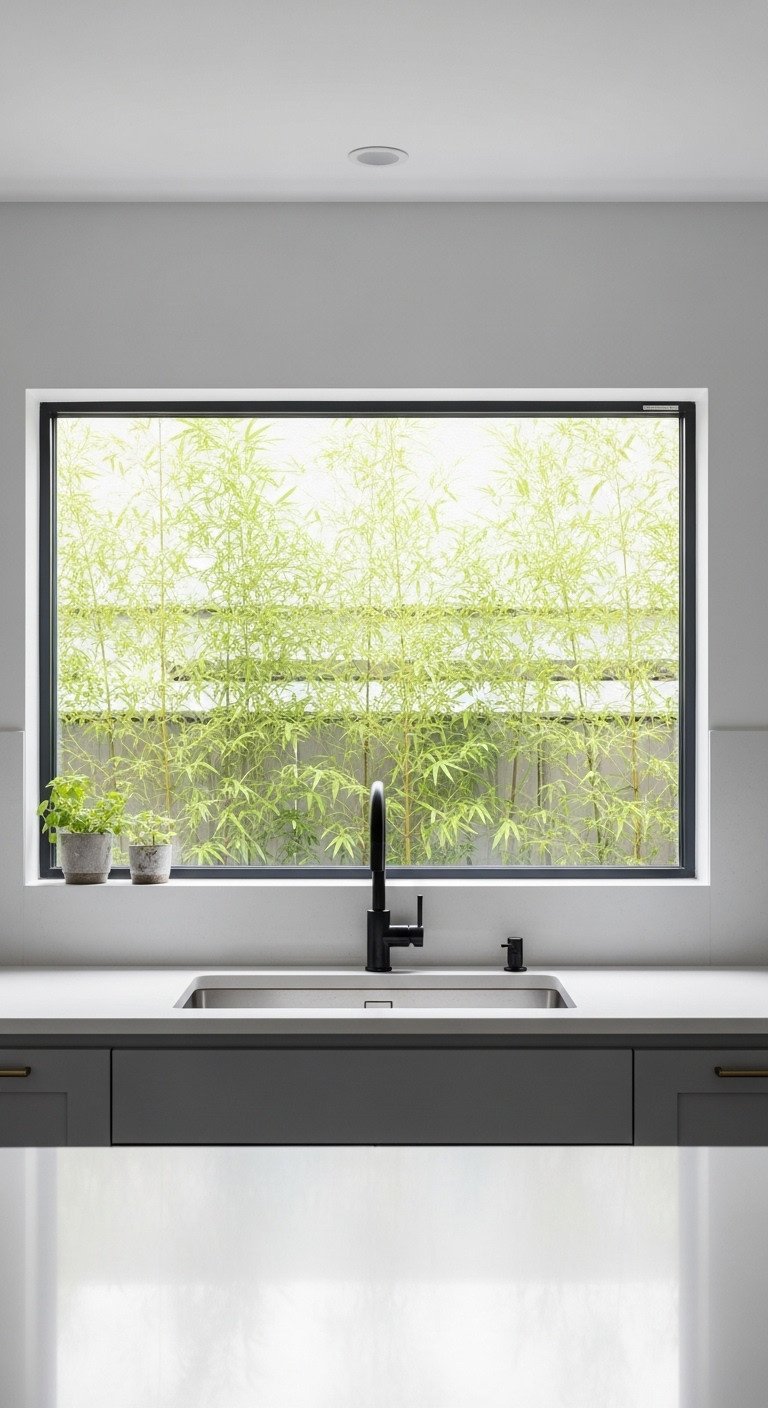
Save this to your ‘Dream Kitchen Views’ board!
- Materials Needed: Sheer linen curtains, potted herbs (mint, basil), small bonsai tree, shoji-style window film.
- Step-by-Step Directions:
- If you have a window, make it a focal point. Maximize the incoming light by removing heavy blinds or drapes. Opt for sheer, natural fabric curtains like linen that soften the light without blocking it, or simply leave the window bare.
- Bring living greenery inside. Place a small collection of potted herbs like mint, basil, or shiso on the windowsill for both their beauty and culinary function. A single, well-cared-for bonsai tree can also serve as a beautiful, living sculpture.
- If you lack a pleasant view or need to enhance privacy, you can mimic the beautiful effect of traditional Japanese paper screens. Apply a translucent, shoji-style rice paper window film to your glass. This diffuses light beautifully, creating a soft, harmonious glow.
- Keep your windowsills clear of all other clutter. This maintains an unobstructed visual and energetic connection to the outdoors, no matter how small the window.
Pro-Tip: Even if you live in an apartment with no garden view, you can still apply this principle. Placing a large, clean-lined mirror on the wall opposite a window will amplify the natural light and reflect the sky, creating a much greater sense of openness and light.
5. The Secret of “In’ei Raisan”: Master Thoughtful Lighting
Mastering thoughtful lighting is about creating a layered and serene ambiance through a combination of different light sources. This concept, inspired by the Japanese aesthetic essay “In Praise of Shadows,” values soft, diffused light over harsh, uniform brightness. A modern Japanese kitchen achieves this with a layered approach: ambient lighting for overall illumination (e.g., recessed fixtures), bright task lighting directly over countertops, and soft statement or accent lighting over an island or dining area. Fixtures themselves often feature minimal shapes and warm, natural materials to contribute to the cozy, harmonious environment.
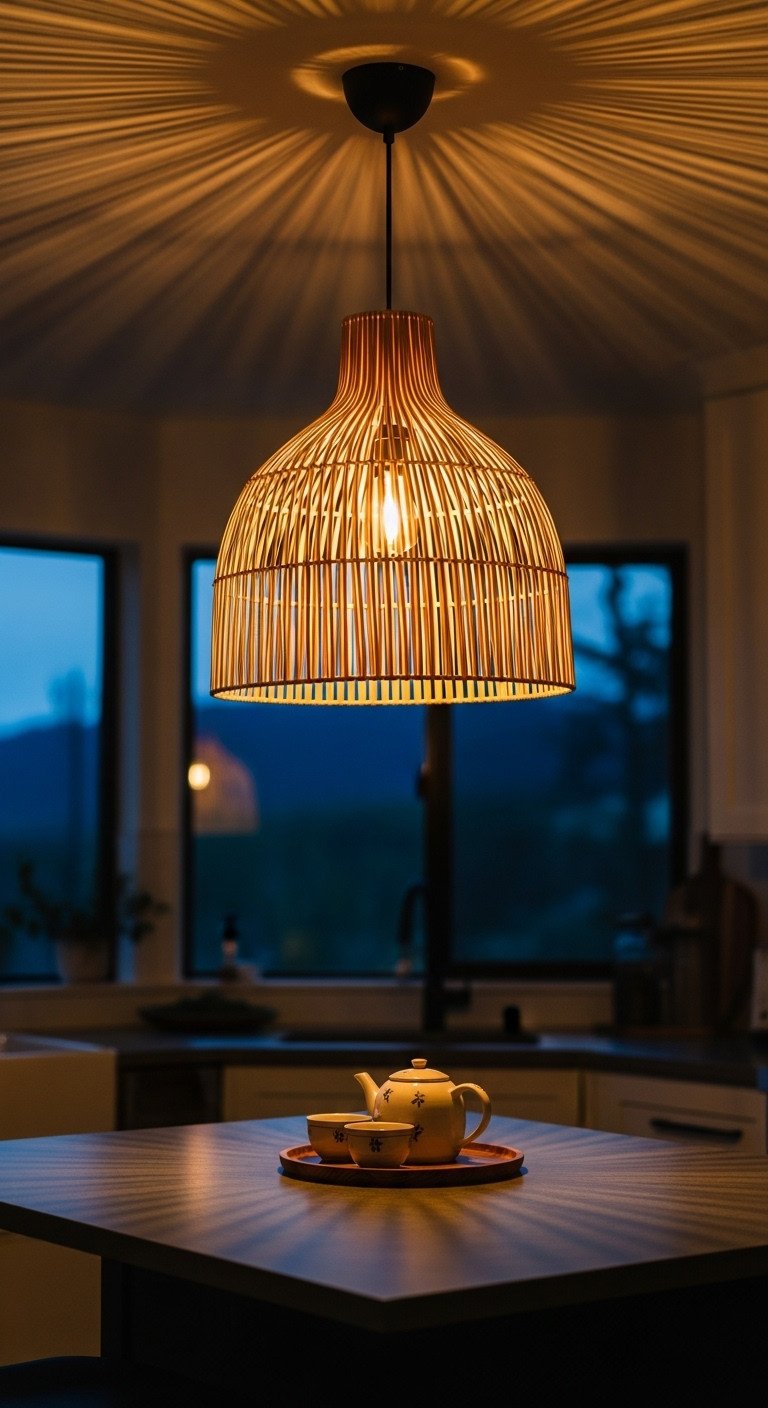
Love this vibe! Saving to my ‘Kitchen Lighting’ board.
- Materials Needed: Statement pendant light, dimmable LED under-cabinet lighting kit, recessed ceiling lights, smart dimmer switches.
- Step-by-Step Directions:
- Ambient Layer: Start with your general overhead lighting. Simple, recessed fixtures are ideal as they disappear into the ceiling. The most crucial part of this layer is installing smart dimmer switches to give you complete control over the overall brightness and mood.
- Task Layer: Install a dimmable LED under-cabinet lighting kit. This is non-negotiable for a functional kitchen. It illuminates your countertops for safe and efficient prep work without creating glare. Look specifically for a kit that offers a warm white color temperature (around 2700K to 3000K).
- Accent Layer: Hang a single, beautiful statement pendant light over your island or a small dining area. Choose a fixture made from natural materials like woven bamboo, wood, or rice paper to act as a sculptural focal point, even when turned off.
Lesson Learned: Always choose “warm white” bulbs for a Japanese-inspired kitchen. Harsh, “cool white” or “daylight” bulbs (typically 4000K and above) can make the beautiful natural wood and stone materials feel sterile and cold, which completely ruins the serene, cozy effect you’re trying to achieve.
6. The Secret of “Wabi-Sabi”: Use Intentional, Minimal Decor
The secret of “Wabi-Sabi” is to find beauty in imperfection and simplicity by choosing decor that is sparse, intentional, and meaningful. In line with minimalist principles, decorative elements in a Japanese kitchen are chosen to complement the space rather than clutter it. This means moving away from mass-produced trinkets and focusing on items with texture, history, or natural beauty. Even functional items can serve as decor when they are well-designed and beautifully crafted.
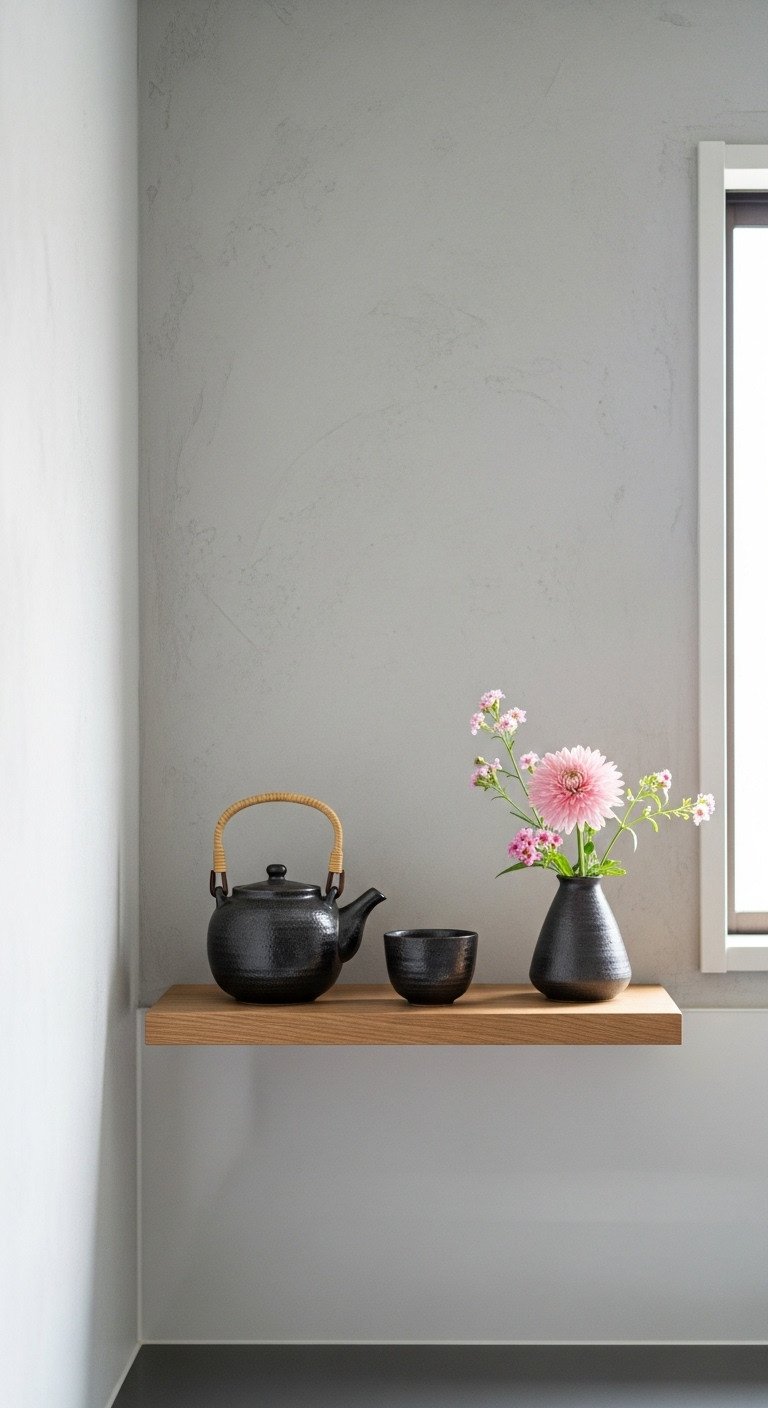
Saving this beautiful shelf styling idea!
- Materials Needed: Floating wood shelves, handmade ceramic pieces (bowls, vases), linen tea towels, a simple piece of wall art, an Ikebana starter kit.
- Step-by-Step Directions:
- Embrace the “less is more” philosophy. Instead of displaying many small items, choose one or two larger, more meaningful pieces, like a beautiful handmade ceramic bowl or a sculptural wooden cutting board.
- Focus on adding texture. A beautiful, high-quality linen dish towel draped over the oven handle or a rough, handmade ceramic bowl on an open shelf can serve as subtle, functional decor.
- Bring in nature with a single branch or a few flowers arranged in the Ikebana style, which values space and form. A small, purpose-made Ikebana flower arrangement vase, often featuring a built-in “kenzan” (pin frog), makes creating these simple, elegant arrangements very easy.
- Let your functional items be beautiful. Invest in a well-designed ceramic soy sauce dispenser, a beautiful set of knives, or a cast-iron teapot that you are happy to have on display.
Pro-Tip: Rotate your decorative items seasonally. This practice keeps the space feeling fresh and alive, and it prevents the accumulation of permanent “clutter.” A single, dramatic branch of cherry blossoms in the spring can have more visual impact than a dozen static items that stay out all year round.
7. The Secret of “Gijutsu”: Fuse Modern Tech with Tradition
The secret of “Gijutsu,” or technology, lies in seamlessly integrating contemporary appliances and smart features while maintaining a traditional, natural aesthetic. The modern Japanese kitchen is a masterpiece of hidden functionality. Appliances are often built-in and concealed behind cabinet panels to create a sleek, uninterrupted look. This fusion allows for the highest level of modern convenience without compromising the clean lines, natural feel, and serene atmosphere that define the style.
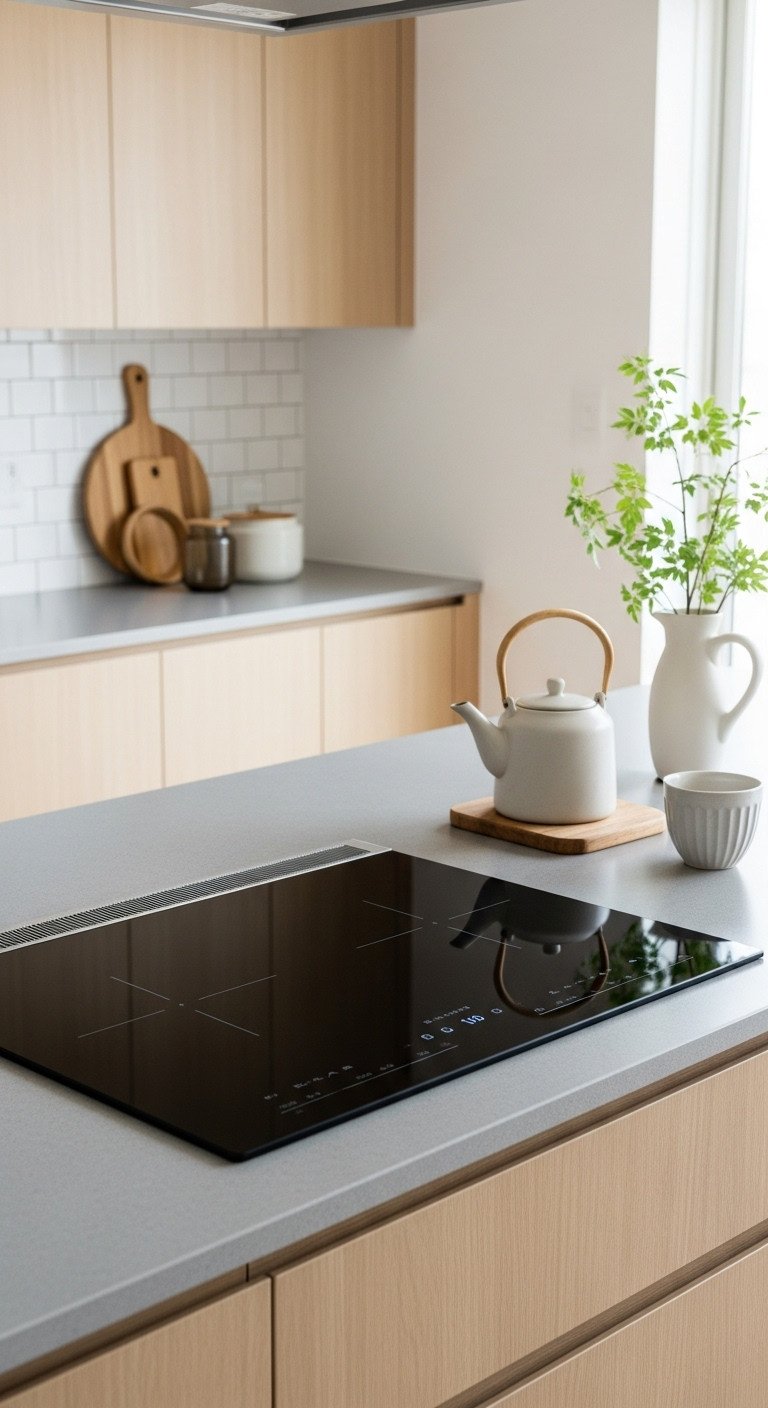
So sleek! Adding to my ‘Modern Kitchen Tech’ board.
- Materials Needed: Panel-ready appliances (dishwasher, fridge), flush-mount induction cooktop, touchless kitchen faucet, under-cabinet smart speaker.
- Step-by-Step Directions:
- When appliance shopping, look for “panel-ready” models. These are designed to be faced with your custom cabinet fronts, allowing your dishwasher and refrigerator to disappear completely into the wall of cabinetry.
- Opt for a flush-mount induction cooktop. Its flat, seamless glass surface is incredibly easy to clean and maintains the minimalist aesthetic far better than a bulky gas range with heavy grates.
- Install smart, functional fixtures that reduce both visual and physical clutter. A minimalist touchless kitchen faucet in a matte black or brushed nickel finish is both beautiful and highly practical for keeping germs at bay when your hands are messy.
- Hide smaller tech items. Create a designated charging station inside a drawer or place a compact smart speaker on a hidden shelf inside an upper cabinet to maintain clean, clear surfaces.
Pro-Tip: When selecting new appliances, prioritize those with the quietest operation, which is measured in decibels (dBA). A quiet dishwasher or refrigerator is just as important for maintaining a serene, Zen-like atmosphere as the visual design. A noisy appliance can easily disrupt the peace.
@juicedkitchens Kitchen design across countries and cultures is interesting. Why do you think the kind of aspirational kitchen / editorial content differs between Japan and the US? Which do you prefer? #sustainabledesign #kitchenremodel #kitchentok #kitchendesign #greenscreen
Key Takeaways: Your Quick Guide to a Japanese Kitchen Layout
Feeling inspired? Here is a quick, scannable summary of the core principles to remember as you plan your serene and functional kitchen transformation.
- Focus on Minimalism: Keep your surfaces clear and ensure every single item has a purpose and a designated storage place. Less is truly more.
- Use Natural Elements: Ground your design with the warmth and texture of wood, the coolness of stone, and an earthy, neutral color palette to bring a sense of nature indoors.
- Prioritize Flow: Don’t just place appliances randomly. Organize your kitchen into efficient work zones (prep, cook, clean) to make the entire process feel intuitive and effortless.
- Maximize Light & Greenery: Use large windows, sheer coverings, and thoughtfully placed indoor plants to blur the line between your kitchen and the outdoors.
- Decorate with Intention: Ditch the clutter. Choose a few beautiful, functional, or handmade items that bring you joy and add character without overwhelming the space.
People Also Ask About Japanese Kitchen Layout
What is a Japanese style kitchen?
A Japanese style kitchen is defined by its core principles of minimalism, functionality, and a deep connection to nature. It features clean lines, clutter-free surfaces, natural materials like wood and stone, and a neutral color palette. The layout is meticulously planned for an ergonomic, “zen” workflow, creating a space that is both peaceful and highly efficient.
How do I design a Japandi kitchen?
To design a Japandi kitchen, you should fuse the minimalism of Japanese aesthetics with the cozy functionality of Scandinavian design. Use light-colored woods (like oak), a warm neutral color palette (whites, grays, beige), and maintain clean, simple lines. Emphasize natural light and materials, and decorate sparingly with high-quality, handmade ceramics, green plants, and functional items that are also beautiful.
What are the four types of kitchen layout?
The four main types of kitchen layouts are the Galley (two parallel walls), L-Shape (two perpendicular walls), U-Shape (three walls), and Island (any layout featuring a detached counter space). The beauty of Japanese design is that its core principles of workflow, minimalism, and smart storage can be effectively applied to any of these foundational layouts to optimize flow and aesthetics for any size kitchen.
Final Thoughts
Ultimately, a kitchen is far more than just a place to prepare meals; it is the true heart of the home, a space for creativity, nourishment, and connection. By incorporating these seven secrets of Japanese kitchen layout, you are not just organizing your cabinets or choosing new countertops. You are intentionally creating an environment that supports a calmer, more mindful way of living. You are building a sanctuary that is a source of joy and ease, not stress and clutter.
This approach proves that a kitchen can be both a high-performance workspace and a peaceful retreat. It’s about finding the perfect balance between beauty and function, tradition and modernity.
Which of these secrets are you most excited to try in your own kitchen? Let me know in the comments below
Last update on 2025-11-15 at 00:54 / Affiliate links / Images from Amazon Product Advertising API
